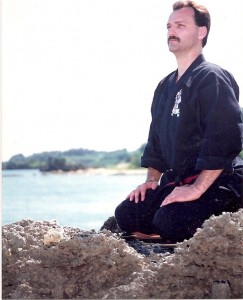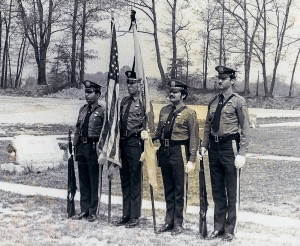“I Segreti dei Maestri” – Le Tre Condizioni Primarie
“Quando la vita ti mette in mano limoni , fai la limonata …”
Man mano che la nostra vita scorre, passiamo attraverso delle fasi di sviluppo che, se vogliamo esaminarle piu’dettagliatamente, possiamo suddividere in: sviluppo fisico, intellettuale , emozionale e spirituale. Questi quattro “pilastri” sono in modo figurativo le “gambe” che supportano il “tavolo” che costituisce ciascuna delle nostre vite.
Per un Artista Marziale serio, raggiungere la meta del suo viaggio, significa in sostanza, aquisire “equilibrio” in ognuna di queste aree di sviluppo. Questa “ricerca” in particolare, fa la differenza tra un “Artista marziale” e un “Tecnico marziale”. Un artista marziale deve essere anche un tecnico marziale, tuttavia, un tecnico marziale non deve necessariamente essere un artista marziale.
Questo concetto di equilibrio si costruisce con la contrapposizione e l’integrazione di tutti e quattro questi aspetti interdipendenti. Il ruolo del Maestro di AM è quello di creare nel Dojo, insieme con le attività pertinenti, un ambiente che fornisca terreno fertile per lo sviluppo di ciascuno di questi quattro pilastri. (more…)
“Secrets of the Masters” – the Three Primary Conditions
“When life hands you lemons, make lemonade…”
As we proceed through life, each of us passes through similar stages of development. We can further subdivide each of these stages to examine Physical Development, Intellectual Development, Emotional development, and Spiritual development. These four “pillars” are the figurative “legs” that support the particular “table” that constitutes each of our lives.
For the serious Martial Artists, the overall journey ultimately becomes a quest to achieve “balance” in each area of development. This “quest” particularly distinguishes the difference between a “Martial Artist” and a “Martial Technician”. A Martial Artist must also be a Martial Technician, however, a Martial Technician is not necessarily a Martial Artist.
This concept of balance is pursued further by the contrasting and integration between all four of these interdependent facets. The role of the MA Master is to create an atmosphere in the Dojo, along with pertinent activities, that provide a fertile environment for development of each of these four pillars. (more…)
Law Enforcement and Martial Arts – the “Best” Connection? – Part 3
…this is PART 3 and the final article of this 3 part series.
Liability Issues
A significant issue that has come to the forefront concerning LE physical encounters is that of both Criminal and Civil Liability. The proper “Use of Force” has advanced “front and center” as a primary concern. Along with other changes in the society where we presently live, this new “information age” presents unique challenges where any of us could be taped on a video with a cell phone and end up on “You Tube” within minutes of the occurrence.
Changing Society
The United States has become an ever increasing litigious society with less and less respect and consideration for the LE officer. Many times the officer has only seconds to make a decision that may affect his safety and/or of that of others while the news media and even the courts have days, weeks, and months to scrutinize every little nuance of those decisions. Although some laws and precedents exist that provide some support for the officer who acts within the law, the experience of enduring all the public and legal scrutiny following any questionable encounter can be career changing for many officers. It can also quickly and easily undermine the credibility and effectiveness of any given LE agency. (more…)
Forze dell’Ordine e Arti Marziali – Il “miglior” rapporto? – Parte 3
… Questa è la 3a e ultima parte di questa serie.
Questione di responsabilità
Una questione importante che è venuta alla ribalta riguardo gli scontri fisici delle FO è quella di stabilire se, nel caso, la responsabilità per loro sia penale o civile. Il giusto “uso della forza” è la prima preoccupazione che è stata avanzata e ha messo tutti “sull’attenti”. Insieme ad altri cambiamenti nella società, in cui stiamo vivendo, questa nuova “era dell’informazione” presenta sfide uniche in cui ognuno di noi potrebbe essere registrato su un video con un comune telefono cellulare e finire su “YouTube” in pochi minuti dell’evento.
Una società in evoluzione
Gli Stati Uniti sono diventati una società sempre più litigiosa, con sempre meno rispetto e considerazione per i rappresentanti delle Forze dell’Ordine. Molte volte un ufficiale ha pochissimi secondi per prendere una decisione che può influire sulla sua sicurezza o su quella altrui. Invece i media, o anche i tribunali hanno settimane, mesi o anni di tempo per controllare ogni sfumatura prima di prendere una decisione. Anche se, alcune leggi e alcuni precedenti esistenti forniscono un sostegno per l’ufficiale che agisce all’interno della legge, l’esperienza di essere giudicati pubblicamente e legalmente, dopo uno scontro discutibile, può cambiare la carriera a molto poliziotti. Può anche rapidamente e facilmente compromettere la credibilità e l’efficienza di qualsiasi arma delle Forze. (more…)
“I Segreti dei Maestri” – La Visione Chiara
“Il coltello taglia, ma non può tagliare se stesso , l’occhio vede, ma non può vedere se stesso.”
Man mano che la nostra vita si svolge continuiamo ad accumulare conoscenza. Si tratta di una combinazione tra conoscenza di “prima mano” e conoscenza di “seconda mano”. Personalmente definisco conoscenza di “prima mano” le informazioni che assimiliamo ed elaboriamo attraverso l’esperienza personale. Questo è il “c’ero, l’ho fatto” ed è il tipo di informazione che ha peso sul nostro concetto di vita in generale.
Al contrario, definisco la conoscenza di “seconda mano”, l’accumulare informazioni che ci arrivano da altre fonti. Queste fonti cominciano a partire dalla nostra famiglia (madre, padre, fratelli, ecc) poi amici, colleghi, e più tardi da insegnanti/superiori (in un modo più formale). Fonti meno dirette possono includere scritti, audio o materiale video. A mio parere, è estremamente importante identificare accuratamente la credibilità di tutte le fonti di ogni conoscenza che ci arrivano da “seconde mani”.
Nel valutare la credibilità delle informazioni di prima mano, ognuno di noi ha la tendenza a dare automaticamente a queste informazioni credibilità . Questo succede perché la nostra prospettiva di vita è stabilita sulla base di ciò che vediamo attraverso i nostri occhi, non attraverso gli occhi degli altri. E’ di cruciale importanza ricordare che, la validità delle conclusioni tratte dalla elaborazione di queste informazioni, è la premessa iniziale per avere una “visione chiara” delle cose. (more…)
“Secrets of the Masters” – Clear Vision
“The knife cuts but it cannot cut itself; the eye sees, but it cannot see itself.”
As our individual lives unfold we begin to amass a volume of knowledge. This is a combination of “Firsthand Knowledge” along with much “Secondhand Knowledge”. I personally define “firsthand knowledge” as information that we assimilate and process further through personal experience. This is the “been there, done that” type of information that weighs heavily on our overall concept of life.
In contrast, I define “secondhand knowledge” as information we glean from other sources. Those sources begin with our family (mother, father, siblings, etc.) and then friends, associates, and later, teachers/mentors (in a more formal way). Less direct sources may include written, audio, or video material. In my opinion, it is extremely important to accurately and critically identify the source of all secondhand knowledge when weighing its credibility.
When weighing the credibility of firsthand knowledge we each have a greater tendency to give this information automatic credibility. This may well occur because our perspective of life is established on the basis of what is seen through the lens of our own eyes, not through the eyes of others. It is critical to remember that the validity of the conclusions drawn from processing any information is a function of the original and underlying premise or premises. (more…)
Forze dell’Ordine e Arti Marziali – Il miglior rapporto ? – Parte 2
Questa e’ la PARTE 2 della serie di articoli intitolati “Forze Dell’Ordine e Arti Marziali – Il Miglior Rapporto?”. Aggiornerò l’articolo con una nuova sezione ogni lunedì. (Vi prego di scusarmi per il ritardo di questo post a causa di problemi tecnici)
Ostacoli all’allenamento che viene fondato sulle “Migliori Pratiche”
Dopo aver identificato alcune delle sfide, nel ricevere la formazione di base delle Tecniche Difensive all’Accademia, diventa ancor più importante per i rappresentanti dell’ordine che la formazione iniziale ricevuta sia efficiente, efficace e pratica. Ci sono una quantità di ostacoli che di solito si incontrano sulla strada che porta a raggiungere questi semplici requisiti.
Per primo, la “formazione delle TD di base” che esiste nelle Forze dell’ordine varia significatamente da accademia a accademia e anche da istruttore a istruttore a seconda della scuola. E ‘giusto riconoscere che ci sono alcuni programmi di allenamento, di qualità decisamente elevata nei programmi di formazione del FO/TD, nonostante molti ostacoli. Questo articolo non è da intendersi come un atto di accusa contro l’attuale status quo, ma come un dibattito equo destinato ad ispirare cambiamenti positivi a beneficio dei nostri professionisti delle FO e ad aiutarli nel lavorare in sicurezza. (more…)
Law Enforcement and Martial Arts – the “Best” Connection? – Part 2
This is PART 2 of a 3 part series titled: “Law Enforcement and Martial Arts – the ‘Best Connection’?” A new section adding to this article will be posted each Monday. (Please excuse the delay of this post due to technical difficulties)
Obstacles to “Best Practices” based training
After identifying some of the challenges for officers to even receive DT training beyond the academy basics, it becomes more significant that the initial training received is efficient, effective, and practical. There are number of obstacles that commonly stand in the way of accomplishing these simple requirements.
First, the “basic DT training” that exists in LE today varies significantly from academy to academy and sometimes even from instructor to instructor within a particular academy. It is only fair to acknowledge that there are some remarkably high quality LE/DT training programs in spite of many obstacles. This article is not intended as an indictment against the present status quo but as a fair discussion intended to inspire positive changes to benefit our LE professionals and help keep them safer. (more…)



